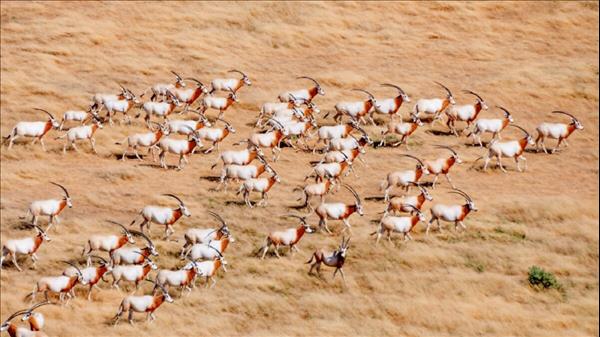
World's Largest Reintroduction Drive To Save Oryx, Addax, Gazelle On Track
Published: Sun 22 May 2022, 12:33 AM
Last updated: Sun 22 May 2022, 6:35 AM
The world's largest mammal reintroduction programme is continuing on a successful track with number of animals in the wild registering a significant rise.
The Environment Agency – Abu Dhabi (EAD) has successfully translocated 20 Scimitar-Horned Oryx (SHO) and 25 Addax to Chad's Ouadi Rime-Ouadi Achim Game Reserve in March.
Due to the programme's efforts, initiated in 2014, the numbers of SHO in the wild reached 460, with 15 calves born this year, as well as 96 wild Addax, with five calves born to the herd this year.
For the first time ever, EAD has also successfully translocated five Dama Gazelle, which have joined the herd of other captured wild Dama Gazelle in the EAD programme.
EAD also darted seven wild animals - six SHO and one Addax - and fitted them with satellite tracking collars to closely monitor the animals and keep track of their survival and reproduction.
Dr Shaikha Salem Al Dhaheri, secretary-general of EAD, said:“This pioneering project was inspired by the vision of the late Sheikh Zayed bin Sultan Al Nahyan, who noticed that SHO numbers were declining rapidly and wished to see them flourish once again. Today we are seeing continued success through the regular translocation of both breeds to their natural habitat in Chad. Both herds of animals are now thriving in their natural habitats.”
The SHO reintroduction programmes strives to create a self-sustaining herd of over 500 heads in the 77,950 sqkm Ouadi Rimé-Ouadi Achim Wildlife Reserve, decades after the species was declared 'extinct in the wild' by the International Union for the Conservation of Nature (IUCN) in 2000.
“We are currently very close to achieving our goal of having a herd of 500 SHO in Chad and, due to the success of this project, we are aiming to go beyond this figure and ensure that the numbers in the wild increase even further. Alongside the SHO herd, we are working with the Chad government to also reintroduce Addax and Dama Gazelles, and in time we will witness increased numbers of these species, hopefully paving the way for their removal them from the extinction danger list,” she added.
The second phase of the reintroduction programme included adding the critically endangered Addax, and in November 2019, the translocation project was launched with the first pilot batch of 15 animals, followed by the second group of 25 Addax in March 2020.
The reintroduction programme of both species involves close collaboration with a range of international partners. These include the Ministry of Environment in the Government of Chad; the Sahara Conservation Fund (SCF); the Zoological Society of London (ZSL); the Smithsonian Conservation Biology Institute (SCBI); Marwell Wildlifel; Royal Zoological Society of Scotland; Saint Louis Zoo WildCare Institute; Fossil Rim Wildlife Centre; and the European Union.

Legal Disclaimer:
MENAFN provides the
information “as is” without warranty of any kind. We do not accept
any responsibility or liability for the accuracy, content, images,
videos, licenses, completeness, legality, or reliability of the information
contained in this article. If you have any complaints or copyright
issues related to this article, kindly contact the provider above.


















Comments
No comment